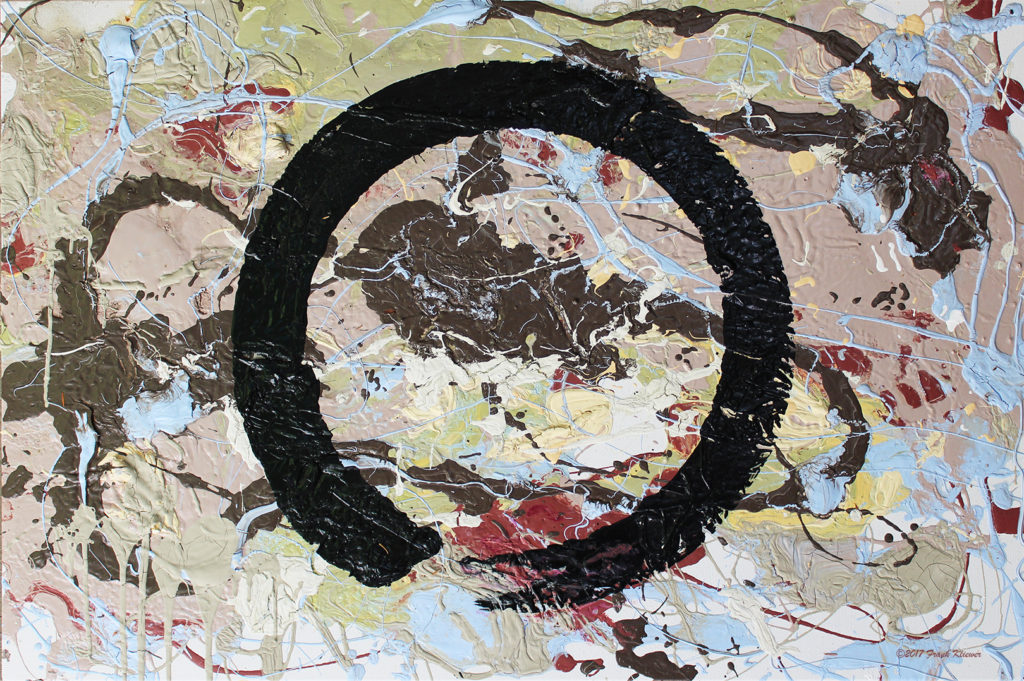
This acrylic and oil painting is on a 24×36 canvas.
Title: Inner Peace
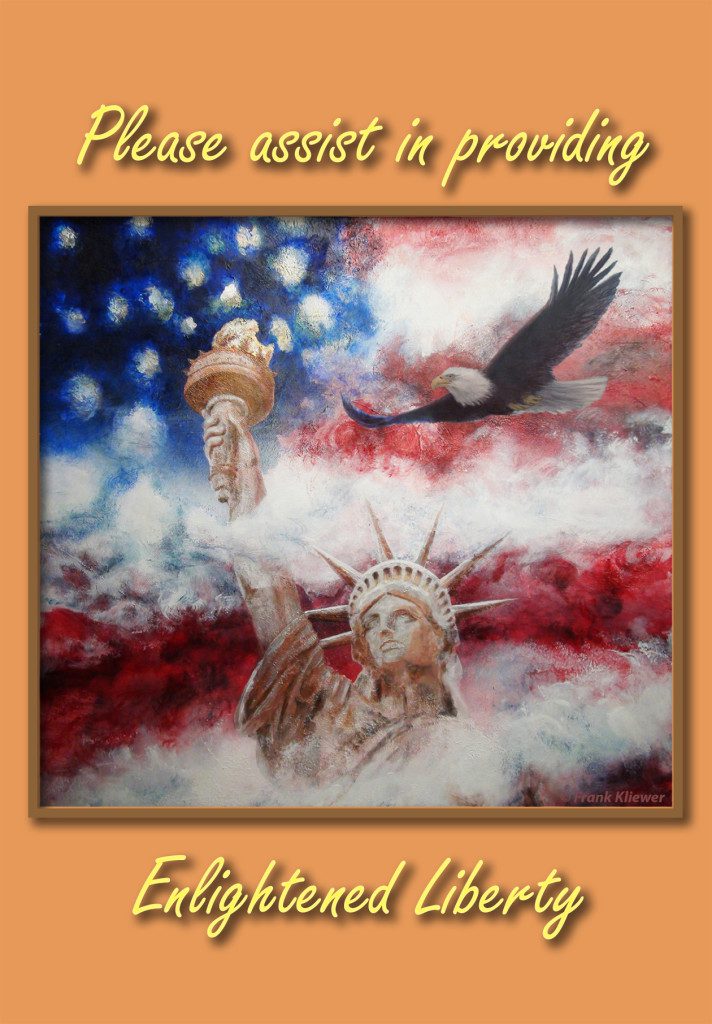
In 1886, U.S. President, Grover Cleveland, ordered that one of our statues serve as a lighthouse. This statue was also the tallest iron structure erected as of that date. The electric lights were seen 24 miles away. The statue functioned as a lighthouse for the next 16 years, until March 1, 1902. The original name was, Statue of Liberty Enlightening the World.
The graphic above, is a digital mashup of two of Frank’s paintings, a lighthouse painting (the statue / lighthouse), the other is an eagle from another series, “Masters of the Earth.” They are combined here at his daughter’s request, as the eagle is in honor of her son (Frank’s grandson) now serving in the United States Air Force, as one of our guardians.
Though the United States has changed significantly since its founding, seemingly thrashed about by political conflict these days, the concept of Enlightened Liberty is still the best hope for humanity, to reduce suffering and bring greater peace to our planet. Let us all do what we can to provide a meaningful difference in the world and have our beacon of freedom shine brightly again.
Thank you for your visit here …may you be blessed.
Frank just completed his latest painting titled “Calm” in acrylic on a 30″ x 24″ canvas, delivering a special edition top quality Giclée print to a wonderful supporter today. Frank is makingan image of the painting available free to his friends as a desktop background. Just click-through to the highest resolution.
Text was added to remind us how to find calm in our lives, and borders were added to allow placement of desktop app icons. Enjoy…and takethe opportunity to help others findcalm in their lives as well.
Thank you for visitinghere.
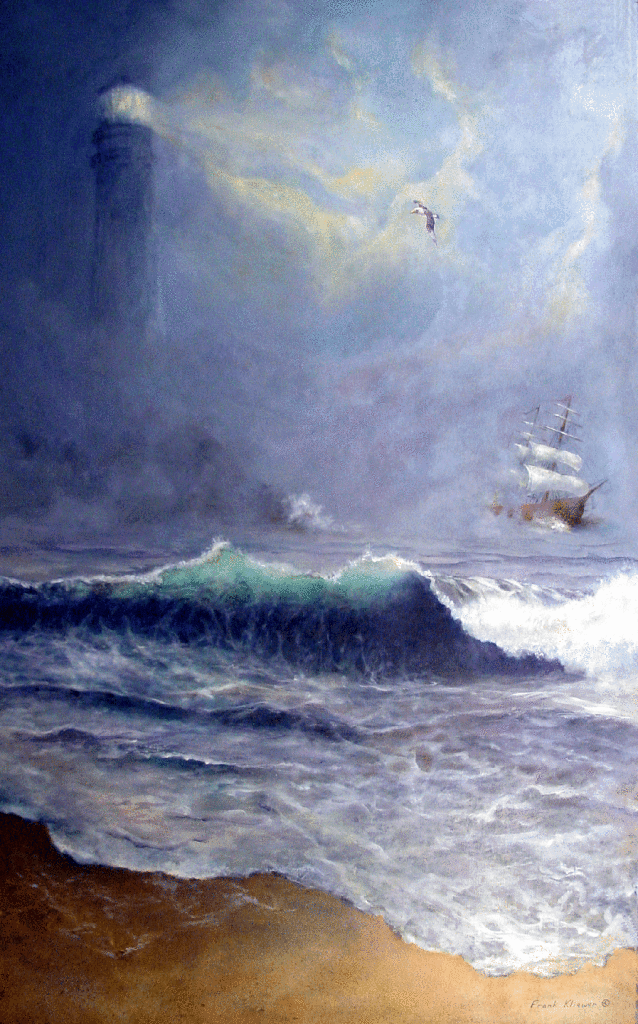
This painting, “Benefaction” is in acrylic on a30″ x 48″ wood panel. Frank portrays the challenge of a foggy day for a typical ship in trying to find its way along arocky and dangerous coast.
It was a very joyful moment to see the light on the shore, while receiving guidance froma friendly sea-bird bringing the ship to the light. This allowed the ship to turnjust in time to miss the hidden rocks and certain catastrophe.
May we all show compassion and do what we can to aid others avoid possible disasters that can appearso quickly for any of us.
This is a story about how friendship isn’t always about just liking something one of your friends has done. Frank was commissioned to do a lighthouse mural in a Silicon Valley office, and asked to paint the mural over a weekend to reduce impact on the business. Frank agreed, as long as the wall was prepared with an undercoat on Friday evening after hours, by a professional painter, according to Frank’s specifications and color. That way it would be dry and ready for the art on Saturday morning, which Frank estimated would take the entire weekend, if all went well. The wrinkle is that when Frank showed up Saturday morning to begin, the wall had not been painted. The “pro” didn’t show.
Frank had to get past his emotional response quickly, not wanting someone’s inability to perform block what hehad promisedto do. So, Frank went outimmediately to shop for and find the paint to do the necessary undercoat. The primer coats were done, but the wall was not dry enough to begin the painting until Saturday night. Thinking of how the keeper of the light would work through the night, Frank could not shrink from his promised duty and painted all night, collapsing to nap occasionally on the seats shown in the photo above.
By late Sunday afternoon, Frank thought the muralwas done, and calledhis wife Mary and others to come view the production, and take him home. Everyone raved when they walked in the door, while Mary showed Frank a quizzical look, after studying the mural. Frank knew that look and placed high value as always on Mary’s artistic eye. Taking her aside, she offered her view toward perfection, suggesting to Frank that the perspective on the two windows on the side of the keeper’s house was a bit askew. Frank stood back, a little bleary eyed, refocused, and saw exactly what she had pointed out while others still went on about how cool the painting had turned out. After thanking Mary for her valuable assistance, it took about 15 minutes to paint the correction. Then a smiling Frank, with Mary’s concurrence, declared the lighthouse mural done.
The business owners were very pleased Monday morning when they showed up for work, writing him a generouscheck, which Frank then shared with his friends in more than one celebration.
So, perhaps it is sometimes good togo beyond just liking something by offering helpful suggestions or comments that can make a difference and improve the outcome of real friendship. May we all be blessed with truefriends looking out for our best interests, and may we share our good fortune with all.
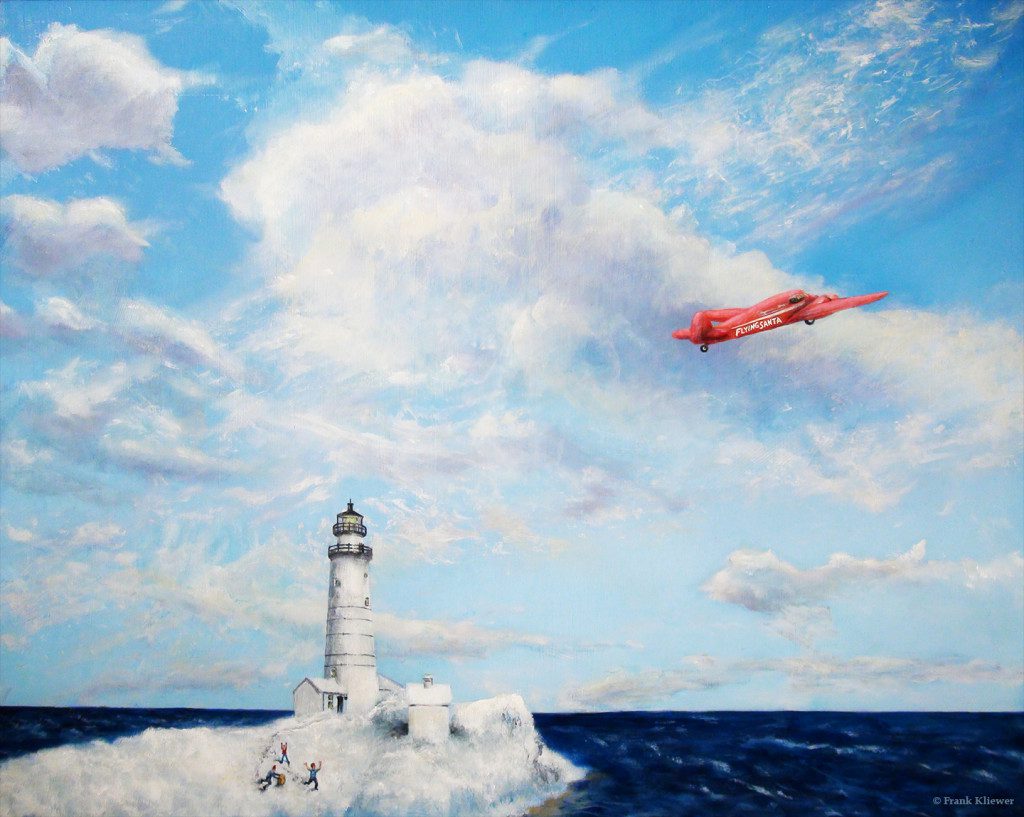
One of our favorite lighthouse traditions is the story of a man who showed uncommon respect for the Light Keepers and their families. Capt. William H. Wincapaw, known as an adventurous and skilled Airman, unknowingly began a tradition in 1929. He was just a guy whowanted to bring holiday cheer to the lighthouse keepers along the East Coast by dropping packages of toys, coffee, shaving supplies, and snacks around Christmas time. He soon became known by the Light Keepers as the Flying Santa. Over the decades the planes and pilots changed, but except for a break during World War II, the practice continues today, now by helicopter.
Frank wanted to pay respect to the tradition and special tribute to the new Airman in the family, his grandson Griffyn. So, the 30″ x 24″ acrylic on wood panel painting was produced and added to Frank’s lighthouse series. The lighthouse seen in this painting is the Boston Light. This is the site of the first lighthouse built in the United States, dating back to 1716, with the current one in the painting built in 1783. This painting honors those who have shownspecial care and concern for the all-important Light Keepers, as well as remote Coast Guard outposts.
We thank all those who bless and protect us with their courage.
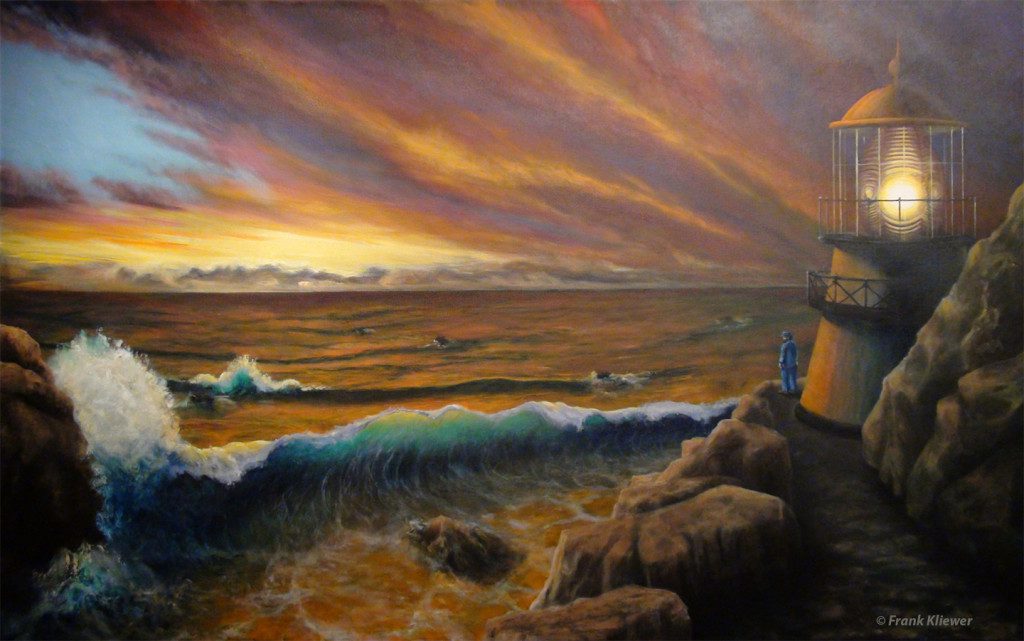
Another lighthouse re-creation painting by Frank is “Cape Mendocino Light” as the original first-order Fresnel lens is now on display elsewhere, replaced by the standard ugly electric beacon. Even the original tower is now gone, misplaced at the entrance to an entertainment center. Frank and Mary visited and sketched the various elements at their current resting places to combine them into the historic perspective presented in the painting.
In this 48″ x 30″ acrylic on canvas, Frank portrays a time when the original lens was in place, and the full-on effect could be enjoyed along with the setting sun if you were to find your way down the path to the remote location at just the right time.
The Light Keeper has done well, as the light is on before sunset. He is freeto enjoy the show as an enlightening experience well-earned by his disciplined work.
Ben Franklin, perhaps the most virtuous of the Founding Fathers of the United States, is often misquoted as saying “Lighthouses are more helpful than churches.” What he really said in a letter to his wife on July 17, 1756 after almost being involved in a shipwreck was, ” Were I a Roman Catholic, perhaps I should on this occasion vow to build a chapel to some saint, but as I am not, if I were to vow at all, it should be to build a light-house.”
Franklin was an inventor, scientist, and statesman. Among Franklin’s inventions was the beginning of the American society. Franklin led a life based on virtue, something almost totallylost on today’s entertainment based culture. Perhaps the pendulum will swing back toward the virtue of caring about others at least as much as we care about ourselves for starters.
No matter if you agree with good old practical Ben’s values, a good practice is repeating usefulactions, like a Light Keeper at the same time every day, faithfully…as others might becounting on you.
Even if there are obstacles in your way, or others try to block your path, just get out there and do the right thing anyway. Most likely there will be those who will value and appreciate what you do. But, even if you are alone on your journey, it is your journey after all, soyou have the power to make the right choices and find joy in those actions.
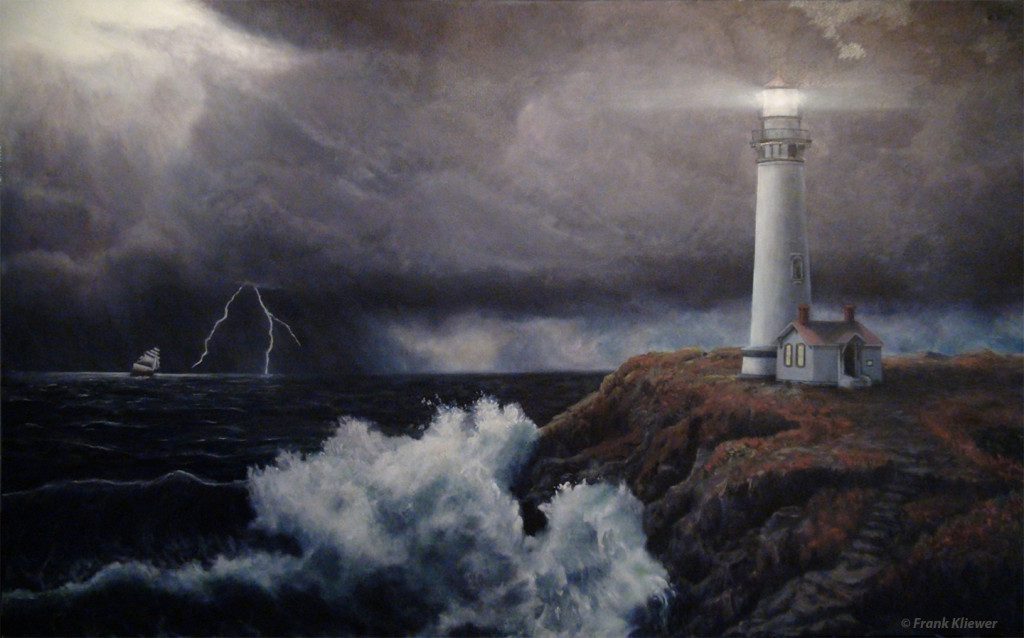
If you Google “lighthouse in a storm” and then select the art category along the top, you’ll probably find an image of Frank’s Pigeon Point Lighthouse painting from one of the sites displaying his work near the top of the results. Pigeon Point is probably the most photographed lighthouse on the west coast due to its classic shape.
You can see the lighthousedriving alongCalifornia Highway 1, 20 miles south of Half Moon Bay and 27 miles north of Santa Cruz. Heck, you don’t even have to leave your car, or even slow down to snap a picture of this beauty…such a shame. You should have to walk to enjoy this kind of setting…all the cars just ruin the effect of this cathedral.
Frank painted this work both “plein air” at the site on a sunny day, and thenback in his studio for the storm effects. (You can click-through the picture to get a more detailed view.) Frank’s landscape teacher thought the painting too dark to become popular.
When traveling the Pacific coast, Frank and Mary were struck by the stories of lighthouse keepers, and their dedication to working the lights to protect the lives of people traveling along the treacherous shores.
This 48″³ x 30″³ acrylic on canvas painting “Racing the Storm at Pigeon Point” above is part of a series of lighthouse paintings by Frank. In this series, he re-creates settings from over 100 years ago, when the lights were critical life savers, while including some contemporary views and stories as well.
There were no electronics to guide the ships. The critical mechanics of the lights were driven by weights, pulleys, and gears. The Light Keepers kept the lights burning with oil and kerosene before electricity, sending beams of light over twenty miles out to sea. A daily practice of hard work by the Light Keepers was absolutely critical to keep a light working.
Frank has found his painting copied on other sites and even used in a YouTube video…but he is OK with that, as long as those that use his work share their profit from it with him.
Today, we should show our greatest respect to those who labor to make things of value to our lives, and treat them with fairness.
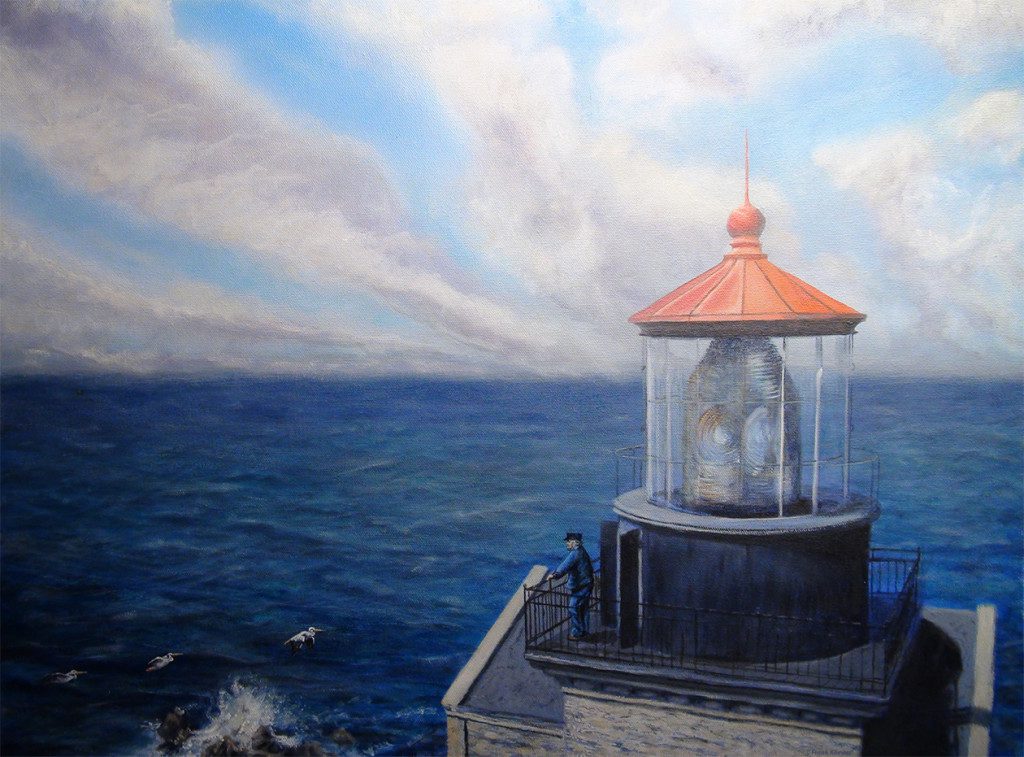
In a re-creation painting of Point Sur Light (24″ x 18″ acrylic on stretched canvas) Frank honors the way the Point Sur Lightstation would have looked over 100 years ago when afirst-orderFresnel lensguided the ships at sea. Today, a muchless glamorous electric beacon guides the way.The original beacon is housed in theMaritime Museum of Monterey. The 580 glass prisms of the historic Fresnel lens from the Point Sur Lightstationillustratejust one of the regular chores of the Light Keepers, as they needed to keep them polished and cleaned of the salt air, to effectively shine the burning beacon of light 20 miles out to sea.
In the painting Frank puts Del, the docent featuredin yesterday’s post, out enjoying the light of day and the swooping sea birds frolicking above the surf.
These times of solitary reflection and enjoyment of the surroundings were really quite rare. If you are interested in the amazing details of the Light Keeper’s job requirements, check this out:http://www.lighthousefriends.com/Instructions%20for%20lightkeepers.pdf The language in use is quite entertaining…enjoy and perhaps gain some extra respect for the workthese technicians performed throughout their days and nights.
Blessings and respect to all who serve and protect.
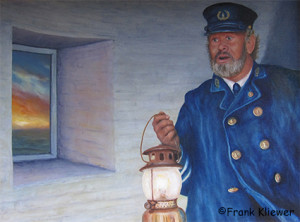
This painting titled “Light Keeper” (oil and acrylic on canvas 24″ x 18″) is a portrait of a modern-day docent, Del, at the Point Sur Lighthouse in California. Apart from the cap he was wearing and his portrait, the rest is Frank’s researched imagination.
The drill for the Light Keeper over 100 years ago was to have the big light on a half hour before sunset, and keep it going until a half hour after sunrise. This painting depicts him running to make his appointed time with the setting sun.
It took a dedicated person to keep a lighthouse flame going so it would project its lifesaving light 20 miles out to sea. Light Keepers were highly respected by most for their critical, yet lonely work. Often isolated far away from busy towns, they would sometimes workthrough the night to keep the light burning and the emerging technology of gears and pulleys functioningto turnthe massive lens shiningits distinctive light code, revealing aspecific place.
Keeping the light burning and the hundreds of lens prisms polished, was a very disciplined and courageous practice. It may seem romantic, being at the seashore and all, but the reality is that some of the Light Keepers went over the edge, either figuratively orliterally, while fulfilling their lonely duties. Some landlubbers on the shore just took the Light Keeper’swork for granted, even scoffing at their value or disrespecting their lifestyle.
The captains and crews of the vessels plying the coastal waters had great respect for the unseen Light Keepers. These traders and builders of commerce showed their support for those protecting them from unseen dangers. It would have been unheard of to demean their vital work or cast aspersions on their lives.
Today,we all should show proper respect and consideration to those who labor to make our lives better. We need to give appropriateconsideration to those who serve us with their skills,seeking toprotect and serve those in danger, lest shame fall on us for being thoughtless and inconsiderate.